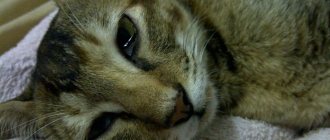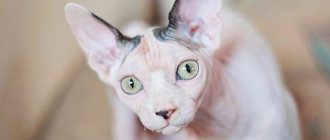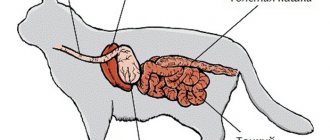Definition of disease
Feline viral peritonitis is a highly contagious disease characterized by damage to the immune system. The peculiarity of FIP is a very long incubation period and the absence of specific symptom complexes that complicate early diagnosis.
Pathogen
FIP is caused by RNA viruses, which are classified as coronaviruses. This family is large, but only two strains affect cats:
- Feline enteric coronavirus (FECV, feline viral enteritis). Manifests itself as symptoms of gastrointestinal disorders (diarrhea, vomiting). After about 3-5 days, the symptoms subside, and it seems that there is no longer an infection in the animal’s body. In fact, the cat remains a carrier of the virus for a long time and releases it into the external environment.
- Feline infectious peritonitis virus (FIPV, feline viral peritonitis). In the early stages it has no specific symptoms and begins spontaneously and suddenly. It is characterized by damage to the immune system (T-lymphocytes - macrophage cells), depriving the body of its main defense against external pathogens.
There is an opinion that the causative agent of viral enteritis (FICV) causes dry peritonitis in cats, and the causative agent FIPV causes its wet form.
Diagnosis of the disease: what tests the doctor performs
Purulent peritonitis in cats is diagnosed in this way. First of all, the doctor must collect an anamnesis, check with the owners in what conditions the animal is kept, whether it has had stress, intestinal disorders, or whether any operations have been performed. The doctor should also find out whether there was contact with street animals, because the pet could have contracted the virus from them. If the cat lives with other cats in the house, then it should be isolated from them during treatment.
Next, the doctor must examine the cat and measure the temperature. In addition, the following tests are performed:
- Ultrasound examination and x-ray. These studies will help identify inflammatory processes in the abdominal region and the presence of damage to internal organs.
- Laparoscopy and biopsy - allow you to determine whether there is effusion of exudate, as well as the presence of pathogenic bacteria.
- A complete blood count and immunohistochemical examination of the tissue obtained during the biopsy are also performed.
Thanks to these tests, the doctor can understand that you are dealing with peritonitis, and not with ascites, cardiovascular diseases, oncology, tuberculosis or toxoplasmosis.
Mechanism of disease development
The coronavirus penetrates through the villi of epithelial cells lining the oral or nasal cavity and nasopharynx. Further, pathogenesis can develop in two ways: either a dry form with initial symptoms of digestive disorders, or a wet form, which has no specific symptoms at the first stage.
In the dry form of feline infectious peritonitis, the virus can remain in the body for a very long time and not manifest itself in any way. But under certain circumstances, its virulence increases (a kind of natural passage of the strain) and its pathogenicity increases sharply.
Important! The virus can “sleep” in a cat’s body for a very long time. Perhaps this is influenced by the general condition of the body, its ability to resist pathogenic agents.
With the wet form of feline infectious peritonitis, the process develops much more dynamically, but specific visual signs appear only in the last stages.
After the virus becomes as pathogenic as possible, the immune system responds by releasing macrophages into the blood - T lymphocytes, and then B lymphocytes. These are tools of humoral immunity that are responsible for the formation of a specific immune response and nonspecific protection.
Most often, these measures are enough to overcome the disease, but there are a number of pathologies in which viral particles infect cells of the immune system. These are immunodeficiency diseases, which also include peritonitis.
In this case, the main target of the virus will always be the immune system and its “tools”. This is the only protector of a living organism that nature has endowed it with.
During a viral attack, the released macrophages do not fully perform their function - they absorb aggressive particles, but cannot kill them. As a result, the virus feeds on the reserves of the affected macrophage, destroys it and comes out unharmed.
But the pathogenic effect of the virus does not end there; it penetrates all organs and tissues. A large number of aggressive particles accumulate in places where there are many small capillaries - in the liver, spleen and other organs.
When the immune system is weakened, under the influence of the virus, the porosity of the capillaries (the permeability of the vascular walls) increases and part of the liquid fraction of the blood goes beyond their limits. Fluid accumulates in the abdominal cavity, causing ascites (dropsy) and inflammation of the peritoneum. This is how a transient wet form of peritonitis develops.
If the immune system is strong enough, it actively resists and manages to produce antibodies to the virus. Then the process of struggle is delayed, but all internal organs are also involved in it. This is the dry form of FIP.
Pathological changes
A standard complication is the accumulation of viscous clear fluid in the abdomen or chest area, sometimes with visible flakes and fibrin thread.
This same fibrin forms a film covering the tissues and membranes of internal organs. At the same time, they become dim, and mini-spikes are observed in different areas.
Moreover, whitish foci of rotting are often found there, surrounded by compacted exudate (taking the form of small nodes or plaques with a diameter of up to 10 mm). This affects the liver, pancreas, intestinal wall and other membranes through which necrosis penetrates.
In the lungs there are fewer such formations, and the pathways themselves acquire a rich scarlet color, often becoming denser.
The clinical picture also includes enlargement of the kidneys against the background of the appearance of single white nodes, absorbed into the cortical composition.
Did you know? When frightened, a cat can jump to a height 5 times its height.
With proliferative dynamics, foci of inflammation arise, covering the eyes and nerve endings, cardiovascular lines and the lower abdominal region.
Routes of infection and spread of peritonitis
A cat becomes infected through contact with a source of infection. Coronaviruses do not have significant resistance to environmental factors. After identifying an infection, it is recommended to wait 2-4 months (depending on the disinfection treatments carried out in places of detention) before getting a new animal.
The virus can be transmitted through contact and nutrition. In addition to sick animals, household items can serve as a source of infection - feeding dishes, tray, bed, and so on. Also, a sick cat can transmit the infection to kittens during birth or feeding.
FIP is a common disease, more often found in places with large concentrations of animals (in shelters, nurseries, at exhibitions).
Attention! Cats under 2 and over 10 years of age are most susceptible to FIP. British cats have a predisposition to viral peritonitis.
Causes of peritonitis in cats
In cats, the most common viral peritonitis is caused by the coronavirus. There are several ways of transmission: fecal-oral, airborne and transplacental, when infection occurs in utero through the placenta from a cat to its offspring.
Once in the body, the virus begins to actively multiply and is released along with feces into the environment. This process continues for several months and stops as soon as antibodies are produced.
If there is a high concentration of the virus in the animal’s environment, re-infection is possible.
There is another option: once a cat becomes infected, it does not get sick, but becomes a carrier and a source of infection for other animals.
Clinical symptoms of peritonitis
Clinical symptoms of peritonitis in cats can be varied, but this disease does not have specific symptom complexes.
Wet form (exudative)
If this is a strain that immediately causes the wet form of FIP, then there are no specific symptoms, but general signs of illness are present:
- temperature increase;
- oppression;
- refusal to eat or noticeable loss of appetite;
- anemic.
After the first nonspecific symptoms, signs of dropsy and peritonitis in the cat rapidly develop:
- Ascites and/or pleural/abdominal effusions.
- Low-grade or intermittent fever.
- With effusion into the pleural cavity, breathing problems occur.
- Weight loss.
- On palpation there is an enlargement of the liver and mesenteric lymph nodes.
- When the disease spreads to other organs, symptoms characteristic of their dysfunction.
- Sometimes (usually in the dry form) damage to the nervous system and eyes.
Dry form (non-exudative)
If this is a strain that initially causes viral enteritis, then a picture of gastrointestinal distress begins to develop:
- Appetite decreases or is absent altogether, weight decreases.
- Activity is reduced.
- Vomiting and diarrhea appear.
- Pallor of visible mucous membranes.
- Damage to the nervous system and eyes appears.
- Body temperature rises.
Further, the clinical picture of peritonitis develops depending on which organs are involved in the process. These may be signs of diseases of the respiratory system, digestion, liver, and circulatory system.
Main signs and symptoms
Viral diseases in cats: infections, symptoms, treatment
Infected cat:
- eats poorly, sometimes refuses food for several days in a row, including his favorite treats;
- loses weight;
- becomes apathetic (stops playing, avoids affection, hides).
Accumulation of fluid in the cat's abdominal cavity.
Tests show that the animal has anemia. The cat is shivering, its body temperature rises above the prescribed 39 degrees. Signs of the disease depend on the form. So, a cat’s abdomen sometimes increases in size, which makes it difficult for the animal to move. If a cat jumps even from a small height, then after landing a sound is heard, similar to what occurs when a bag of water falls.
Some cats have:
- breathing problems (the animal suffocates, after running it becomes short of breath, it becomes almost impossible to breathe through the nose, which is why it almost always makes wheezing and whistling sounds);
- convulsions;
- violation of movement coordination;
- vomiting, diarrhea;
- nodules on the skin;
- inflammation of the eyes, change in the color of their iris.
The virus affects the abdominal cavity, central nervous system, intestines, eyes and brain of the animal. In severe cases, paralysis occurs immediately, bypassing the signs described above, such as apathy, lack of desire to eat and weight loss. The kidneys, liver, and pancreas change in size, increasing in size, and the cat’s skin turns yellow. Internal organs become lumpy.
Differential diagnoses
The dry form of FIP is differentiated from the following diseases:
- cardiomyopathy;
- liver diseases (including tumors);
- purulent serositis;
- lymphosarcoma;
- obesity.
The wet (exudative, exudative) form of FIP is differentiated from the following pathologies:
- feline leukemia virus;
- feline immunodeficiency virus;
- oncological diseases;
- hyperthyroidism (in older cats);
- toxoplasmosis;
- fungal infections;
- idiopathic diseases;
- urinary tract obstruction;
- autoimmune anemia;
- Feline spongiform encephalopathy.
Forms of viral peritonitis
Viral peritonitis is divided into two types, each of which has its own symptoms, course and chances of cure. FIP happens:
- wet. The wet form of peritonitis is an acute type of pathology. During its development, the vascular system is damaged and protein leakage is observed, provoking the accumulation of transudate in the abdominal, pleural or pericardial cavity. This condition develops from two to four months and in 98% of cases ends in death for the animal.
- dry The dry form of FIP in cats is considered chronic and leads to the formation of plaques on internal organs. Diagnosed in animals with strong immunity. The severity of the development of the disease will depend on the organ in which the infectious process develops. The development of the disease lasts up to six months. Dry FIP in cats has a more favorable prognosis as it can be put into remission.
Most often, the wet form of the pathology is diagnosed. In veterinary practice, cases are sometimes recorded when two forms of the disease develop simultaneously.
Diagnostics
Peritonitis is very difficult to diagnose. Lifetime diagnosis cannot be based solely on history taking and visual examination. Even a very experienced specialist is not able to determine FIP with 100% accuracy without additional laboratory tests. But even among them there is not a single one who would immediately confirm the presence of a virulent strain of coronavirus.
History taking
Collecting information about the animal is necessary for the veterinarian to quickly understand what diseases to focus on when making a diagnosis. This includes the owner’s “complaints” and his interview with a specialist.
The anamnesis includes the following information:
- view;
- floor;
- age;
- live weight;
- breed;
- availability of preventive vaccinations and treatments against ecto- and endoparasites;
- type, conditions of keeping and feeding;
- information about appetite, urination and defecation;
- Body temperature;
- frequency and purity of breathing, heart contractions;
- assessment of animal behavior (active/inactive, odd behavior);
- information about past illnesses;
- information about the presence of stressful situations and contacts of the sick person with other animals in the recent past.
Important! The more accurately the anamnesis is collected, the faster the diagnosis will be made. Typically, owners do not attach importance to many aspects of their pets' lives and do not talk about them. In such cases, the veterinarian himself asks the necessary questions.
Laboratory methods for diagnosing peritonitis
To confirm the diagnosis of “feline infectious viral peritonitis” in any of its forms, it is necessary to conduct research using several methods and obtain a confirmatory result for each of them.
To diagnose peritonitis, the following methods are used:
- Cytological and biochemical examination of effusion from the abdominal and/or thoracic cavity.
- Biochemical and hematological blood tests.
- Serological tests for the presence of antibodies (ELISA, RTGA, RN).
- To indicate the virus - reverse CPR, RIF, ELISA (analysis of circulating immune complexes).
- Histopathological examination of affected tissues.
Materials for laboratory research can be:
- whole blood;
- blood serum;
- effusion;
- saliva;
- feces;
- rectal swabs;
- particles of organs and tissues.
Important! In the wet form of peritonitis, the clinical signs are obvious, while in the dry form they may be subtle.
Instrumental methods
Instrumental examination involves the use of special veterinary (medical) equipment. If FIP is suspected, the following is performed:
- Ultrasound of the abdominal cavity (to identify granulomas on internal organs, accumulation of exudate, intestinal inflammation).
- Abdominal puncture (to collect a sample of exudate).
- X-ray (to determine the presence of abdominal ascites).
- Biopsy (for histological examination).
Important! X-rays are only ordered if the cat is experiencing shortness of breath or difficulty breathing.
How is FIP Diagnosed?
Diagnosis of FIP is carried out on the basis of a comprehensive examination, the following methods are used:
- Anamnesis collection. The data gives an idea of the conditions of detention, past diseases, and contacts with virus carriers.
- Inspection. Allows you to identify disturbances in the functioning of the heart, enlarged liver, lymph nodes, ascites.
- X-ray and ultrasound. Show changes in internal organs, the presence of fluid and granulomatous formations.
- Testing. It is carried out using immunofluorescence analysis (IFA). The test detects antibodies to the virus in the blood and effusion. Reverse CPR detects the presence of coronavirus in the feces, saliva or blood of a sick animal.
- Exudate analysis. Based on the condition of the fluid and chemical properties, the disease can be excluded or diagnosed.
Carrying out laparoscopy and taking a biopsy is the most reliable method for diagnosing peritonitis and proves the presence of pathological changes in tissues.
Treatment and prognosis for peritonitis
The prognosis for FIP is extremely poor. With the wet form of the flow, the life expectancy of a pet usually does not exceed 6 months. There is no effective treatment for feline viral peritonitis.
Any of its forms ends in death. If the animal is not in satisfactory physical condition, with a confirmed diagnosis, veterinarians recommend euthanasia, since attempts to treat this disease cause a lot of physical suffering to the cat, and the animal itself is a source of infection.
Meanwhile, with the dry form of peritonitis, an animal can live up to 5 years with appropriate maintenance therapy. Only a veterinarian can prescribe it.
Predictions for the animal
The wet form of VIP is more severe: the prognosis for life is always unfavorable: only 6-7 months. The dry variety, with proper care, allows cats to live a couple of years longer, but such data is also not entirely indicative: in cats with this form of infection, repeated tests showed a negative antibody test result - the cat was probably already at the “healing” stage at the time the first ones were taken analyses.
global $ads_google; //data-ad-slot=”2475549904″ $ads_google = empty($ads_google) ? false : true; ?> if ($ads_google == false) {?>
$ads_google = true; ?> } ?>
If you quickly remove the effusion fluid, the disease can turn into a dry form.
Control and prevention of peritonitis
There is no specific prevention of FIP with proven effectiveness yet. Therefore, the main preventive measures are considered to be:
- Strengthening immunity and nonspecific resistance.
- Preventing stressful situations.
- Limit contact with unfamiliar and suspicious (for diseases) animals.
- Control of animal cleanliness.
- Compliance with hygiene standards.
- Proper nutrition.
- Visit the veterinarian once every 6 months for a preventive examination.
In kittens
There are no special rules for preventing FIP for older kittens, so the same techniques apply to them as for adult animals. But if kittens are born to a sick cat, then they are taken from their mother as early as possible - at the age of 4-6 weeks, until they stop receiving her ready-made antibodies to FIP through breast milk.
This is due to the short period of decay of maternal antibodies. A kitten that is removed from an infected mother later in life can also become infected with the coronavirus.
Important! At 10 weeks of age, it is recommended that kittens be tested for antibodies to FIP.
Prevention in places of detention
Where there are large numbers of cats, prevention and control are limited to the following measures:
- Disinfection of places of detention and care items.
- Maintaining quarantine when new animals appear.
- Compliance with general preventive measures for FIP.
In clinically healthy cats infected with coronavirus
The presence of antibodies to coronavirus does not at all prove that the cat has FIP. For cats without clinical signs of FIP, but with a low titer of antibodies to coronavirus, it is recommended:
- Avoid stress.
- Provide balanced nutrition and rest.
- Postpone previously planned surgical interventions, preventive vaccinations and treatments, matings.
- Later, recheck the blood for the presence of antibodies to coronavirus. If they disappear, then you can return to the normal rhythm of life. If the number of antibodies has increased, then you should undergo a detailed examination and, if necessary, treatment.
How to prevent infectious peritonitis
Today there is no effective vaccine against coronavirus. In the USA, it is under development, but has not yet passed all the required stages of research. In this regard, the vaccine is prohibited in Europe and Russia.
Many experts in the field of veterinary medicine believe that good living conditions and a favorable psychological climate will allow cats or cats to avoid the development of such a terrible disease as peritonitis. Among the measures to prevent animal infection are:
- prevent eating the excrement of other cats;
- in case of a large concentration of animals in a relatively small area, for example, in an apartment, keep pregnant cats separately from other animals; the same rule applies to kittens and older pets;
- ensure a favorable psychological climate, absence of stress;
- strengthen immunity;
- give multivitamin complexes recommended by a veterinarian;
- periodically process or change the animal’s things: tray, bowls, toys;
- See a veterinarian regularly;
- avoid contact with other cats, especially street cats;
- Follow the veterinarian’s recommendations after surgery or sterilization of the animal.
Facts and myths about PCI
Since feline infectious viral peritonitis is a serious disease with no cure, many different speculations have spread around it. The most common are the following:
- FIP virus and coronavirus are one and the same. FIP is an abbreviation for a specific disease, and coronavirus is the name of a family of viruses that have a similar structure and properties.
- A cat became infected at an exhibition. An animal can become infected with coronavirus, but whether it will cause FIP or not depends on the characteristics of the body.
- A cat with FIP is contagious to all other pets. Infected animals secrete the virus, but peritonitis does not always develop and not in everyone who has been in contact with a sick animal.
- Cats with FIP always have a large, pear-shaped abdomen, indicating advanced ascites. But this symptom alone is not enough to make a diagnosis. Viral peritonitis in cats can occur without such a stomach.
- FIP tests. There are no tests for FIP, they can only detect the presence of antibodies to coronavirus.
- FIP is a hereditary disease that is not passed on from parents to offspring with genes. The development of pathology is facilitated by the presence of coronavirus in the body and a weak immune system.
- The vaccine will provide 100% protection against this disease. There is no vaccine against FIP in the Russian Federation, and the effectiveness of the drug developed in Europe and the USA has not been proven.
- If a cat at home died of peritonitis, then you can get another one only years later. The peritonitis virus is not resistant to environmental factors and is destroyed when treated with disinfectants. Therefore, after 3-4 months you can safely buy another cat.
- FIP is transmitted to humans. FIP can only develop in felines.
Infectious viral peritonitis in cats is a fatal disease that is not fully understood. It is not dangerous to humans or other animal species. There is no effective vaccine to prevent the development of this disease.
Prevention of peritonitis comes down to strengthening the health of the animal, its immune system and nonspecific resistance. Therefore, it is very important to feed and maintain your pet properly, avoid stress, and visit a veterinarian twice a year for preventive maintenance.
No one can say for sure how long cats with FIP or coronavirus live, but following simple rules can help avoid the development of infection.
How can a cat become infected?
Most often, a cat receives the pathogen through infected feces from an already sick animal. The FCoV virus can enter the body through mucous membranes by coming into contact with sick cats or by visiting a place where there is their feces.
Sometimes cats re-infect themselves by licking themselves. According to statistics, up to 40% of cats are infected with the peritonitis virus during their lives, which, however, in most cases goes unnoticed by their owners.
Failure and green light for the virus to mutate into a dangerous type can be given by other infections that weaken the immune system, surgery, pregnancy, change of place of residence, change of diet. Genetics also plays a role in triggering the development of the disease. In general, this issue is still open to discussion in scientific communities.
Can a person become infected with peritonitis?
There is no reason for owners of infected cats to worry about themselves and their loved ones: people are not infected with feline coronavirus.











